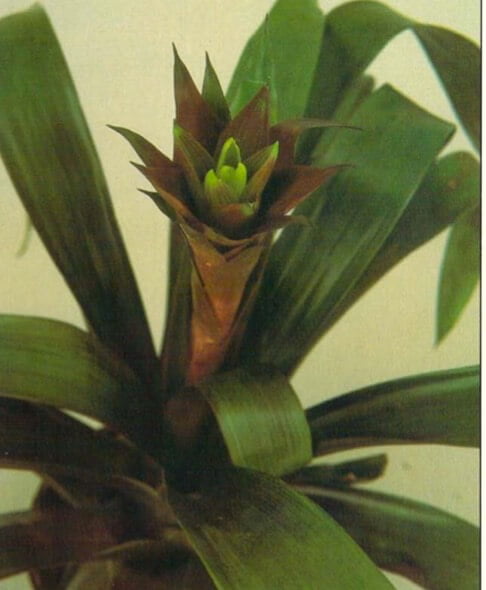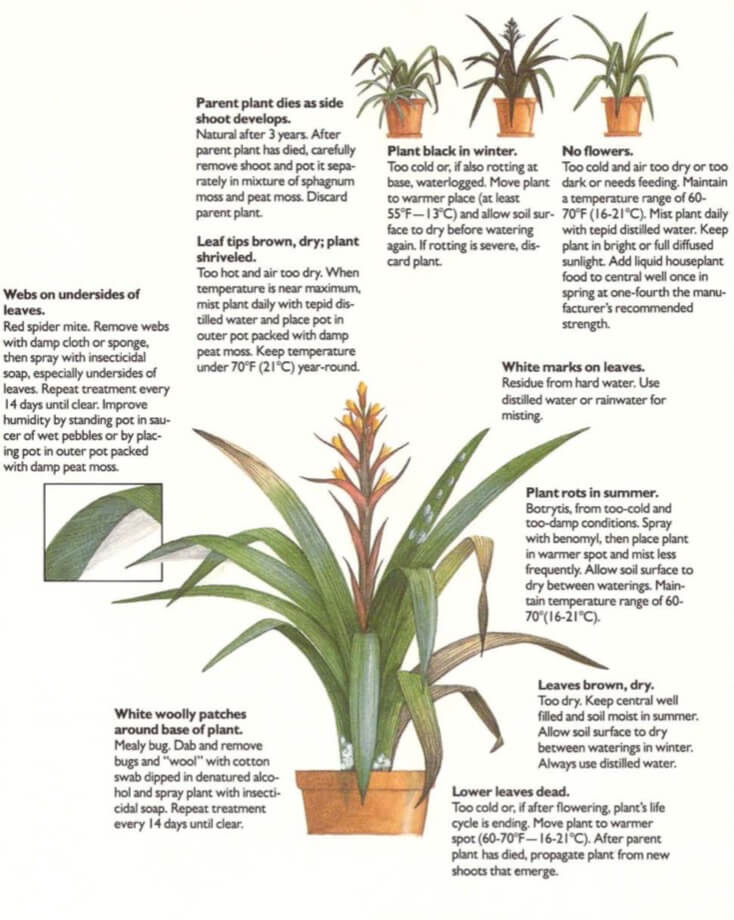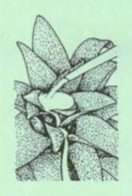[Ebook Việt Hoá] The Instant Guide to Healthy Houseplants (Hướng dẫn tức thời để chăm cây trong nhà khoẻ mạnh), Chi Guzmania
[Ebook Việt Hoá] The Instant Guide to Healthy Houseplants: Guzmania lingulata (Scarlet star)
- Nguồn: [Ebook Việt Hoá] The Instant Guide to Healthy Houseplants (Hướng dẫn tức thời để chăm cây trong nhà khoẻ mạnh)
- Biên tập: Dũng Cá Xinh
- Biên dịch: Team Codai.net
English
In its natural habitat – South America and the West Indies – Guzmania lingulata usually grows in the boughs of trees. The plant’s outstretched leaves funnel small amounts of rain into its well-shaped center, from which the flower bracts emerge. The strap-shaped leaves tend to lose some of their color as the wine-red bracts develop. The bracts last up to 8 weeks and produce small pale yellow flowers. Like all bromeliads, scarlet star flowers only once in its 3 – year life span, then produces offsets from its base.

Light
Needs full diffused sunlight year-round. Shade from direct sunlight.
Temperature
Maintain a temperature range of 60-70°F (16-21°c) in spring and summer. Plant will tolerate a low temperature of 55°F (13°C) if humidity is also low. Provide good ventilation when temperature is near maximum.
Cleaning
Every 2 months, wipe leaves with vegetable oil-based leaf- shine. If leaves are dusty at other times, wipe with damp sponge.
Humidity
Mist plant daily, but do not mist bracts or flowers; they may be damaged by water. (Very high humidity and low temperature can lead to botrytis.)
Feeding
Add liquid houseplant food to central well once in spring at one-fourth manufacturer’s recommended strength.
Repotting
Repot offset after parent plant has dried up.
Soil
Use equal parts lime-free loam and peat moss.
Water
Water plant by filling the central well with distilled water and allowing water to spillover into soil. Keep soil moist in summer, watering twice a week in hot weather. In winter, water when well is empty and soil surface has dried.
What Goes Wrong

- Webs on undersides of leaves: Red spider mite. Remove webs with damp cloth or sponge, then spray with insecticidal soap, especially undersides of leaves. Repeat treatment every 14 days until clear. Improve humidity by standing pot in saucer of wet pebbles or by placing pot in outer pot packed with damp peat moss.
- White marks on leaves: Residue from hard water. Use distilled water or rainwater for
- Plant rots in summer: Botrytis, from too-cold and too-damp conditions. Spray with benomyl, then place plant in warmer spot and mist less frequently. Allow soil surface to dry between waterings. Maintain temperature range of 60-70°F (16 – 21°C).
- Leaves brown, dry: Too dry. Keep central well filled and soil moist in summer. Allow soil surface to dry between waterings in winter. Always use distilled water.
- Lower leaves dead: Too cold or, if after flowering, plant’s life cycle is ending. Move plant to warmer spot 60-70°F (16 – 21°C). . After parent plant has died, propagate plant”from new shoots that emerge.
- White woolly patches around base of plant: Mealy bug. Dab and remove bugs and “wool” with cotton swab dipped in denatured alcohol and spray plant with insecticidal soap. Repeat treatment every 14 days until clear.
- Parent plant dies as side shoot develops: Natural after 3 years. After parent plant has died, carefully remove shoot and pot it separately in mixture of sphagnum moss and peat moss. Discard parent plant.
- Leaf tips brown, dry; plant shriveled: Too hot and air too dry. When temperature is near maximum, mist plant daily with tepid dis- tilled water and place pot in outer pot packed with damp peat moss. Keep temperature under lOaF (21 °C) year-round.
- Plant black in winter: Too cold or, if also rotting at base, waterlogged. Move plant to warmer place (at least 55°F-13°C) and allow soil surface to dry before watering again. If rotting is severe, dis- card plant.
- No flowers: Too cold and air too dry or too dark or needs feeding. Maintain a temperature range of 60- 70°F (16-21°C). Mist plant daily with tepid distilled water. Keep plant in bright or full diffused sunlight. Add liquid houseplant food to central well once in spring at one-fourth the manufacturer’s recommended strength.
Tiếng Việt
Trong môi trường sống tự nhiên của nó – Nam Mỹ và Tây Ấn – Phong lộc hoa thường mọc ở các cành cây. Những chiếc lá vươn ra ngoài của cây sẽ hứng một lượng mưa nhỏ vào tâm có hình dạng tốt của nó, từ đó các lá bắc hoa xuất hiện. Các lá hình dây đeo có xu hướng mất một số màu khi các lá bắc màu đỏ rượu phát triển. Các lá bắc kéo dài đến 8 tuần và tạo ra những bông hoa nhỏ màu vàng nhạt. Giống như tất cả các loài hoa bìm bịp khác, sao đỏ chỉ nở hoa một lần trong vòng đời 3 năm của nó, sau đó tạo ra các nhánh từ gốc của nó.

Ánh sáng
Cần ánh sáng mặt trời khuếch tán đầy đủ quanh năm. Che mát khỏi ánh nắng trực tiếp.
Nhiệt độ
Duy trì phạm vi nhiệt độ 60-70 độ F (16-21 độ C) vào mùa xuân và mùa hè. Cây sẽ chịu được nhiệt độ thấp là 55 độ F (13 độ C) nếu độ ẩm cũng thấp. Cung cấp hệ thống thông gió tốt khi nhiệt độ gần tối đa.
Làm sạch
Cứ 2 tháng một lần, lau lá bằng dầu thực vật bôi lá. Nếu lá bị bụi vào những thời điểm khác, hãy lau bằng miếng bọt biển ẩm.
Nhiệt độ
Cây phun sương hàng ngày, nhưng không phun sương cho các lá bắc của hoa; chúng có thể bị hư hỏng do nước. (Độ ẩm quá cao và nhiệt độ thấp có thể dẫn đến bệnh nấm.)
Bón phân
Thêm phân bón dạng lỏng vào phần giữa một lần vào mùa xuân với nồng dộ bằng 1/4 nhà sản xuất khuyến nghị.
Thay chậu
Thay chậu sau khi cây mẹ đã khô.
Đất
Sử dụng đất mùn không vôi và rêu than bùn với hai phần bằng nhau.
Nước
Tưới nước cho cây bằng cách đổ đầy nước cất vào phần giữa và để nước tràn vào đất. Giữ ẩm cho đất vào mùa hè, tưới 2 lần / tuần khi trời nắng nóng. Vào mùa đông, tưới nước khi nước cạn và bề mặt đất đã khô.
Những vấn đề có thể xảy ra

- Các mạng nhện ở mặt dưới lá: Nhện đỏ. Loại bỏ mạng nhện bằng vải ẩm hoặc bọt biển, sau đó xịt xà phòng diệt côn trùng, đặc biệt là mặt dưới của lá. Điều trị lặp lại sau mỗi 14 ngày cho đến khi khỏi hẳn. Cải thiện độ ẩm bằng cách đặt chậu trong đĩa sỏi ướt hoặc bằng cách đặt chậu trong chậu bên ngoài có phủ rêu than bùn ẩm.
- Vết trắng trên lá: Cặn của nước “cứng”. Sử dụng nước cất hoặc nước mưa
- Cây bị thối rữa vào mùa hè: Bệnh thối rữa, do điều kiện quá lạnh và quá ẩm. Phun thuốc diệt nấm, sau đó đặt cây ở nơi ấm hơn và ít phun sương hơn. Để bề mặt đất khô giữa các lần tưới. Duy trì phạm vi nhiệt độ 60-70 độ F (16-21 độ C).
- Lá nâu, khô: Quá khô. Giữ cho nước ở giữa được lấp đầy và đất ẩm vào mùa hè. Để bề mặt đất khô giữa các lần tưới vào mùa đông. Luôn sử dụng nước cất.
- Chết lá phía dưới: Quá lạnh hoặc nếu sau khi cây ra hoa, vòng đời của cây đang kết thúc. Di chuyển cây đến nơi ấm hơn 60-70 độ F (16-21 độ C). . Sau khi cây mẹ đã chết, hãy nhân giống cây “từ những chồi mới nhú ra.
- Các mảng lông cừu trắng xung quanh gốc cây: Rệp cây. Chấm và loại bỏ bọ và “len” bằng tăm bông nhúng trong cồn biến tính và xịt xà phòng diệt côn trùng cho cây. Điều trị lặp lại sau mỗi 14 ngày cho đến khi khỏi hẳn.
- Cây mẹ chết khi chồi bên phát triển: Tự nhiên sau 3 năm. Sau khi cây mẹ chết, cẩn thận loại bỏ chồi và trồng riêng trong hỗn hợp rêu trắng và rêu than bùn. Bỏ cây mẹ.
- Đầu lá màu nâu, khô; cây bị héo: Quá nóng và không khí quá khô. Khi nhiệt độ gần tối đa, tưới cây phun sương hàng ngày với nước pha loãng và đặt chậu trong chậu bên ngoài phủ đầy rêu than bùn ẩm. Giữ nhiệt độ dưới 10 độ F (21 độ C) quanh năm.
- Cây đen trong mùa đông: Quá lạnh hoặc nếu thối cả gốc, úng. Di chuyển cây đến nơi ấm hơn (ít nhất 55 độ F-13 độ C) và để bề mặt đất khô trước khi tưới lại. Nếu sự thối rữa nghiêm trọng, hãy loại bỏ cây.
- Không có hoa: Quá lạnh và không khí quá khô hoặc quá tối hoặc cần cho ăn. Duy trì phạm vi nhiệt độ từ 60-70 độ F (16-21 độ C). Phun sương cây hàng ngày với nước cất loãng. Giữ cây ở nơi có ánh sáng mặt trời sáng hoặc khuếch tán đầy đủ. Thêm phân bón lỏng vào giữa một lần vào mùa xuân với một phần tư sức mạnh khuyến nghị của nhà sản xuất.
![[Ebook Việt Hoá] The Instant Guide to Healthy Houseplants: Guzmania lingulata (Scarlet star) [Ebook Việt Hoá] The Instant Guide to Healthy Houseplants: Guzmania lingulata (Scarlet star)](https://vn1.vdrive.vn/codai.net/2020/02/ebook-huong-dan-tuc-thoi-cham-cay-trong-nha-khoe-manh-21-guzmaia-lingulata.jpg)



